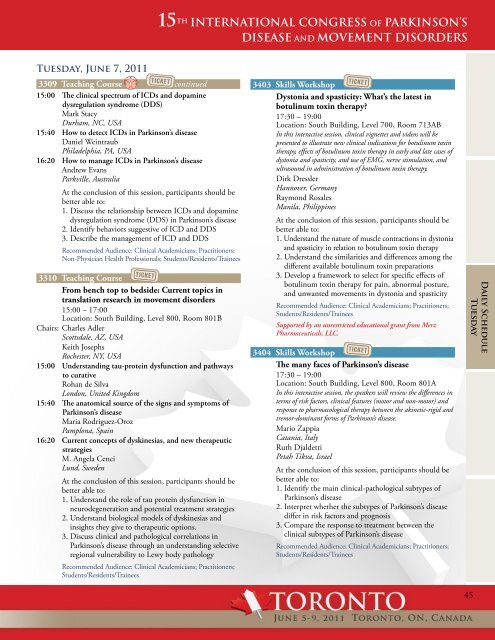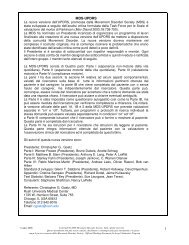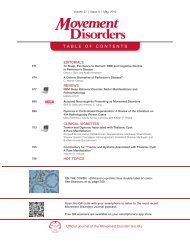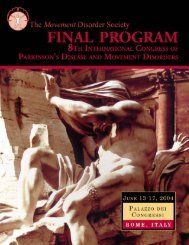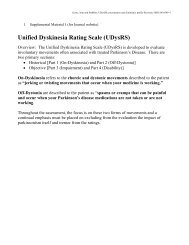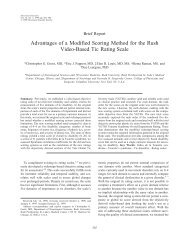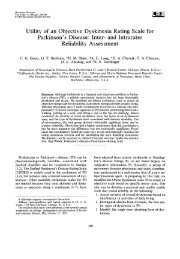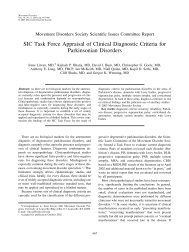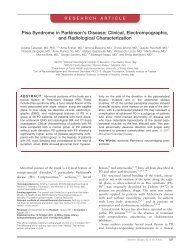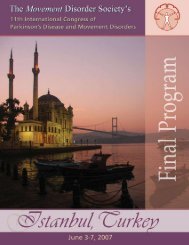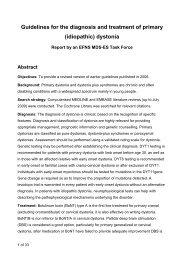15th INTERNATIONAL CONGRESS OF PARKINSON'S
15th INTERNATIONAL CONGRESS OF PARKINSON'S
15th INTERNATIONAL CONGRESS OF PARKINSON'S
You also want an ePaper? Increase the reach of your titles
YUMPU automatically turns print PDFs into web optimized ePapers that Google loves.
Tuesday, June 7, 2011<br />
3309 Teaching Course<br />
15:00 The clinical spectrum of ICDs and dopamine<br />
dysregulation syndrome (DDS)<br />
Mark Stacy<br />
Durham, NC, USA<br />
15:40 How to detect ICDs in Parkinson’s disease<br />
Daniel Weintraub<br />
Philadelphia, PA, USA<br />
16:20 How to manage ICDs in Parkinson’s disease<br />
Andrew Evans<br />
Parkville, Australia<br />
At the conclusion of this session, participants should be<br />
better able to:<br />
1. Discuss the relationship between ICDs and dopamine<br />
dysregulation syndrome (DDS) in Parkinson’s disease<br />
2. Identify behaviors suggestive of ICD and DDS<br />
3. Describe the management of ICD and DDS<br />
Recommended Audience: Clinical Academicians; Practitioners;<br />
Non-Physician Health Professionals; Students/Residents/Trainees<br />
TICKET<br />
3310 Teaching Course<br />
From bench top to bedside: Current topics in<br />
translation research in movement disorders<br />
15:00 – 17:00<br />
Location: South Building, Level 800, Room 801B<br />
Chairs: Charles Adler<br />
Scottsdale, AZ, USA<br />
Keith Josephs<br />
Rochester, NY, USA<br />
15:00 Understanding tau-protein dysfunction and pathways<br />
to curative<br />
Rohan de Silva<br />
London, United Kingdom<br />
15:40 The anatomical source of the signs and symptoms of<br />
Parkinson’s disease<br />
Maria Rodriguez-Oroz<br />
Pamplona, Spain<br />
16:20 Current concepts of dyskinesias, and new therapeutic<br />
strategies<br />
M. Angela Cenci<br />
Lund, Sweden<br />
At the conclusion of this session, participants should be<br />
better able to:<br />
1. Understand the role of tau protein dysfunction in<br />
neurodegeneration and potential treatment strategies<br />
2. Understand biological models of dyskinesias and<br />
insights they give to therapeutic options.<br />
3. Discuss clinical and pathological correlations in<br />
Parkinson’s disease through an understanding selective<br />
regional vulnerability to Lewy body pathology<br />
Recommended Audience: Clinical Academicians; Practitioners;<br />
Students/Residents/Trainees<br />
15 th <strong>INTERNATIONAL</strong> <strong>CONGRESS</strong> <strong>OF</strong> PARKINSON’S<br />
DISEASE AND MOVEMENT DISORDERS<br />
TICKET continued<br />
TICKET<br />
3403 Skills Workshop<br />
Dystonia and spasticity: What’s the latest in<br />
botulinum toxin therapy?<br />
17:30 – 19:00<br />
Location: South Building, Level 700, Room 713AB<br />
In this interactive session, clinical vignettes and videos will be<br />
presented to illustrate new clinical indications for botulinum toxin<br />
therapy, effects of botulinum toxin therapy in early and late cases of<br />
dystonia and spasticity, and use of EMG, nerve stimulation, and<br />
ultrasound in administration of botulinum toxin therapy.<br />
Dirk Dressler<br />
Hannover, Germany<br />
Raymond Rosales<br />
Manila, Philippines<br />
At the conclusion of this session, participants should be<br />
better able to:<br />
1. Understand the nature of muscle contractions in dystonia<br />
and spasticity in relation to botulinum toxin therapy<br />
2. Understand the similarities and differences among the<br />
different available botulinum toxin preparations<br />
3. Develop a framework to select for specific effects of<br />
botulinum toxin therapy for pain, abnormal posture,<br />
and unwanted movements in dystonia and spasticity<br />
Recommended Audience: Clinical Academicians; Practitioners;<br />
Students/Residents/Trainees<br />
Supported by an unrestricted educational grant from Merz<br />
Pharmaceuticals, LLC.<br />
TICKET<br />
3404 Skills Workshop<br />
The many faces of Parkinson’s disease<br />
17:30 – 19:00<br />
Location: South Building, Level 800, Room 801A<br />
In this interactive session, the speakers will review the differences in<br />
terms of risk factors, clinical features (motor and non-motor) and<br />
response to pharmacological therapy between the akinetic-rigid and<br />
tremor-dominant forms of Parkinson’s disease.<br />
Mario Zappia<br />
Catania, Italy<br />
Ruth Djaldetti<br />
Petah Tikva, Israel<br />
At the conclusion of this session, participants should be<br />
better able to:<br />
1. Identify the main clinical-pathological subtypes of<br />
Parkinson’s disease<br />
2. Interpret whether the subtypes of Parkinson’s disease<br />
differ in risk factors and prognosis<br />
3. Compare the response to treatment between the<br />
clinical subtypes of Parkinson’s disease<br />
Recommended Audience: Clinical Academicians; Practitioners;<br />
Students/Residents/Trainees<br />
45<br />
Daily Schedule<br />
Tuesday


